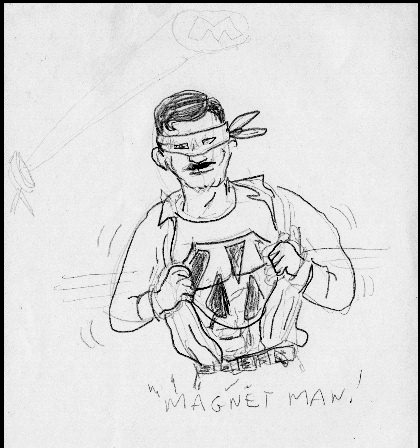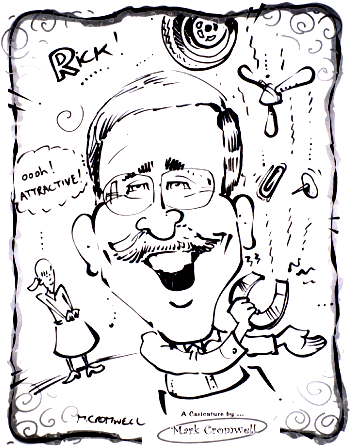


Live demonstrations
Interested in having a live demonstration on "The World of Magnets"?
If you are in the Milwaukee, Wisconsin area and are interested in scheduling a live demonstration of the above exhibits with a talk about all these cool things you can do with magnets, please contact me via e-mail. The demonstration can be customized to fit your time schedule, anywhere from 30 minutes to 90 minutes, depending on what exhibits would be shown and the age of the audience. It is suitable for grades 4 through 12, Cub Scouts, Boy Scouts, Girl Scouts, engineering college students, after dinner talk for a company function, or anyone with an interest in physics.
Magnet Man – Cool Experiments with Magnets
with Rick Hoadley
AGENDA FOR PRESENTATION
What would life be like without magnets?
Everyday we come into contact with many different magnets. Credit cards have a magnetic stripe; audio and video tape recorders use magnetic tape; a speaker requires two magnets (a permanent magnet and an electromagnet) to make the sound that we hear; televisions and computer monitors use an electromagnet to "write" the picture on the TV screen; our clothes washers and dryers have electric (magnetic) motors; automobiles use dozens of tiny permanent magnet motors, solenoid magnets and magnetic sensors.
We examine actions of the "magnetic force": push and pull (attraction and repulsion). What are north & south poles? What is the difference between a permanent magnet and an electromagnet? How is the earth like a giant magnet? How does a compass work?
The "magnetic field" of a magnet can be made visible using iron powder. The magnetism surrounding a wire carrying electrical current can be demonstrated, proving the existence of "electromagnetism."
Why do magnets stick to your refrigerator? Is your cat magnetic? Wood, plastic, aluminum, copper, brass and steel are tested for magnetic properties. Cheerios are slightly magnetic because they contain iron. What four metals are attracted to a magnet? Magnets always attract iron, nickel, gadolinium and cobalt because these four materials can be "magnetized."
An electromagnet is made from a coil of wire. When electricity is flowing in the wire, magnetism surrounds the coil. You can pick up magnetic materials and release them by shutting off the electricity.
Passing a coil of wire through a large magnet causes electricity to flow in the wire. How is electricity generated using magnetism? How much electricity can you make using the "kid" powered flashlight?
A motor shaft rotates because of the magnetic forces between the rotating magnetic fields and the stationary magnets. A speaker converts electrical energy into sound energy so you can hear the beat of the music.
Students will be able to spend some time interacting with the demonstrations in order to personally learn about magnetism.
Professional Background
Rick Hoadley of ABB Inc. will demonstrate many of the “Cool Experiments with Magnets” described on his award winning web site “Magnet Man” at http://www.coolmagnetman.com. Among the hands-on experiments are various methods of levitation using permanent magnets and eddy currents. Several of the executive toys using magnets will also be shown for you to try out. These experiments have been shown to several student groups as a method to learn more than just the basics about magnets and magnetism. Until recently, most of the experiments were either not possible or too expensive for classrooms since powerful Neodymium-Iron-Boron permanent magnets were not readily available. Simulations of magnetic fields using Ansoft’s Maxwell 2D Field Simulation program will also be shared.
Rick Hoadley received the B.S. and M.Eng. degrees in electrical engineering from Cornell University, Ithaca, NY, in 1973 and 1974, respectively. From 1974 to 1987, he had been involved with product development of AC and DC motor drives with Borg-Warner Power Electronics in Ithaca, NY, and the Seco Division of Warner Electric Brake and Clutch in Charlotte, NC. From 1987 to 2009, he was with the Rockwell Automation/Allen-Bradley Co. in Mequon, WI, where he has held technical management positions with their Configured Drives group, Drives Systems group, Drive Systems Product Development group and Standard Drives Development group. In 2009, Rick started working as a Principal Application Engineer with the Medium Voltage Drives group at ABB located in New Berlin, WI. He is also an Adjunct Assistant Professor in the EECS department at the Milwaukee School of Engineering (MSOE). His interests include adjustable speed drives, drive applications, magnets, and teaching engineering.
Rick has authored and presented several papers on AC drive applications at Powercon, AISE, PCIM, IEEE/PCIC, IEEE/IAS and for Allen Bradley’s seminars and publications, and holds patents 4,521,840, 6,657,322, 7656117, 7724549 and 8299732 - all associated with AC drives. He is a life senior member of the IEEE.
He is an alumnus of the Bad Godesberg American School on the Rhine in Bad Godesberg, Germany; Aiglon College in Chesieres-Villars, Switzerland; Dearborn High School in Dearborn, Michigan; and Cornell University in Ithaca, NY.
Rick is also an active member of Trinity Community Church (Reformed Church of America) in Brown Deer, WI, where he has served as elder and adult Sunday School teacher.
Misc Information
Length of Presentation: 45 min to 60 min, depending on age group and class schedule.
Group Size: Ideally 10 – 15 students per presentation. Greater numbers may require a modification to the hands-on section.
Handouts: A worksheet can be made available for copying that will review some of the basics of magnetism by filling in the blanks.
Ages of Students: Grades 4 – 12
Size of Room: A 40' x 40' room works well (basically 1600 sq ft).
Set-up and teardown: I will need about 90 min to set-up, and 60 min to teardown. I have a cart I use to move the boxes from my car to the room, so ramps or elevators around stairs are very helpful.
Safety: The magnets and electromagnets used in the demonstrations are very safe. However, basic rules will be shared with the students before they are allowed to handle the devices.
1. Handle the magnets with care – don’t drop them (they will break), don’t let them snap together (they will break), don’t throw them around (they will break), don’t let your fingers get pinched between the magnets (it will hurt).
2. Place magnets only on items that will not be damaged (not your grandfather’s pocket watch, not on your grandmother’s hearing aid, not your family TV or computer monitor, not on floppy disks)!
Honorarium:
To be determined by number of demonstrations, length of each
demonstration, distance to site.
Additional cost per day to demonstrate superconductors using liquid
nitrogen.
Contact me at [email protected], with "MagnetMan" in the subject field.
EQUIPMENT NEEDS
LCD Projector with cable for connection to a computer
I can provide a laptop, or bring a USB stick with the PowerPoint presentation.
Projection screen (or blank wall)
7 tables, each about 30” x 60”
Two 120Vac outlets, 15Amps
 A sketch of Magnet Man by Dick
Soliva, Milwaukee, 2002
A sketch of Magnet Man by Dick
Soliva, Milwaukee, 2002
 Caricature by Mark
Cromwell in Calgary, Alberta, Canada, 2007
Caricature by Mark
Cromwell in Calgary, Alberta, Canada, 2007
 Caricature by Karen Kovich of
Cleveland, OH, 2008
Caricature by Karen Kovich of
Cleveland, OH, 2008
Caricature by Gail in New Oleans, 2012
Caricature by LS in New Orleans, 2012
Caricature by Chuck Senties in Chicago,
2013
Cariciature by Ray Shipman in Houston,
2015